Ham balls may not be the first thing that comes to mind when you think of comfort food, but trust us—they’re a classic for a reason. This delicious dish, popular in Midwestern kitchens, combines the savory goodness of ham with a touch of sweetness from its signature glaze. Whether you’re hosting a holiday dinner, a potluck, or just craving something hearty, this ham balls recipe will have everyone asking for seconds.
In this guide, we’ll cover everything from the origins of ham balls to expert tips and recipe variations. By the end, you’ll not only know how to make these mouthwatering meatballs but also how to serve them like a pro. So, let’s dive into the world of ham balls and discover why this dish has stood the test of time.
Introduction to Ham Balls
The Origin of Ham Balls
Ham balls trace their roots to the heart of the Midwest, where resourceful cooks found creative ways to repurpose leftover ham. This dish is a perfect blend of practicality and indulgence, turning humble ingredients into something truly memorable. While its exact history remains unclear, ham balls have become a staple at family gatherings, especially during holidays.
Popularity in Midwestern Cuisine
The Midwest is renowned for its comfort food classics, and ham balls fit right in with that tradition. They offer a nostalgic connection to simpler times, where meals were made with love and shared with family. From Iowa to Nebraska, this recipe has been passed down through generations, cherished for its blend of savory and sweet flavors.
Why Ham Balls Are a Must-Try Dish
What makes ham balls so special? It’s their unique ability to combine the savory richness of ham with a tangy, caramelized glaze that’s downright addictive. Plus, they’re incredibly versatile—pair them with mashed potatoes, green beans, or even serve them as appetizers at your next gathering. Ham balls are more than just a recipe; they’re a celebration of home-cooked goodness.
Ingredients Needed for the Perfect Ham Balls (300 words)
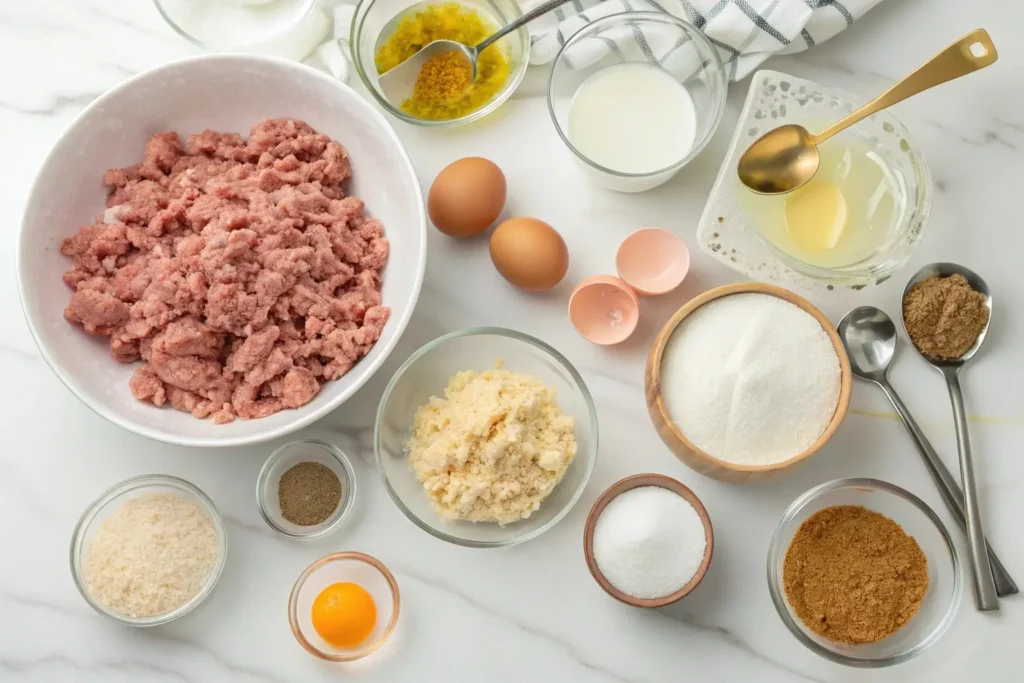
Primary Proteins: Ground Ham, Pork, and Beef
At the heart of any ham balls recipe is the perfect mix of proteins. Traditionally, ground ham, pork, and sometimes beef are combined to create the base. The ham brings a salty richness, while pork adds tenderness, and beef (if used) balances the flavors. You can grind ham at home or use pre-ground ham for convenience. The key is to achieve a texture that’s not too chunky but still holds together well when forming the balls.
Binding Agents: Eggs and Graham Cracker Crumbs
What keeps ham balls from falling apart? The answer lies in the binding agents. Eggs act as the glue, ensuring that all the ingredients stick together, while graham cracker crumbs provide structure and a hint of sweetness. If you don’t have graham crackers, crushed saltines or breadcrumbs can work in a pinch, but graham crackers are the gold standard for that authentic Midwest flavor.
Flavor Enhancers: Onions, Milk, and Seasonings
To elevate the flavor of your ham balls, finely chopped onions are a must. They add a subtle bite and moisture to the mixture. Milk, on the other hand, ensures the meat stays tender during baking. For seasoning, a simple mix of salt, pepper, and perhaps a dash of paprika will do wonders. These ingredients combine to give the dish its distinct, comforting taste.
Step-by-Step Guide to Preparing Ham Balls
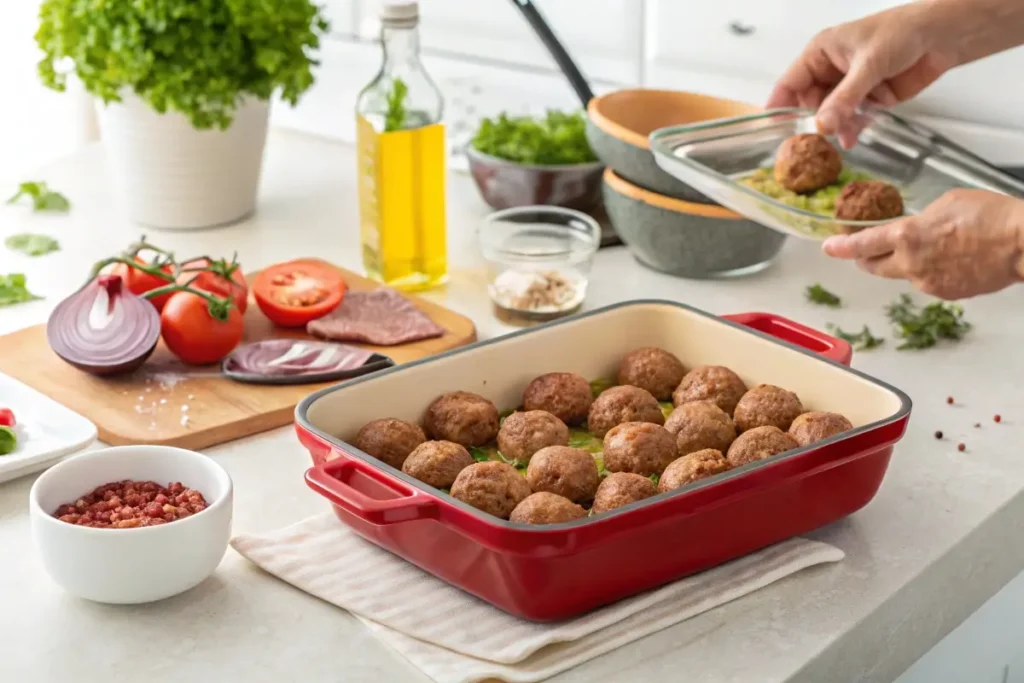
Grinding the Meats: Achieving the Right Consistency
To get started with your ham balls recipe, ensure the meats are ground to the right consistency. If using leftover ham, cut it into small chunks and pulse it in a food processor until finely ground. Combine it with the ground pork (and beef, if desired) in a large mixing bowl. The key here is to create a mixture that blends smoothly without being overly processed.
Mixing the Ingredients: Ensuring Even Distribution
Next, add your binding agents—eggs, graham cracker crumbs, and milk—into the meat mixture. Don’t forget the chopped onions and seasonings! Using your hands is the best way to mix everything evenly. Be sure not to overwork the mixture, as this can make the ham balls dense and tough.
Forming the Balls: Tips for Uniform Size and Shape
Now it’s time to form the meatballs. Scoop small portions of the mixture (about the size of a golf ball) and roll them between your hands until smooth. Keeping the balls uniform in size ensures they cook evenly. If the mixture feels sticky, lightly wet your hands to make the process easier.
Preparing the Glaze: Balancing Sweet and Tangy Flavors
No ham balls recipe is complete without the signature glaze. A simple combination of brown sugar, vinegar, and mustard creates a sweet-and-tangy topping that caramelizes beautifully during baking. Some cooks like to add pineapple juice or ketchup for extra flavor. Whisk the glaze ingredients in a bowl until smooth, and set it aside for the next step.
Baking and Serving Ham Balls
Oven Settings and Baking Time
To achieve perfectly cooked ham balls, preheat your oven to 350°F (175°C). Arrange the formed meatballs in a single layer in a baking dish, ensuring they have a bit of space between them. This allows for even cooking and proper caramelization of the glaze. Pour the prepared glaze over the ham balls, making sure each one is well-coated. Cover the dish with aluminum foil and bake for 30 minutes. Then, remove the foil and continue baking for an additional 30 minutes, or until the ham balls are cooked through and the glaze has thickened.
Basting Techniques for Maximum Flavor
For an extra burst of flavor, consider basting the ham balls halfway through the uncovered baking time. Using a spoon or brush, drizzle the glaze from the bottom of the dish over the tops of the meatballs. This not only enhances the taste but also gives the ham balls a beautiful, glossy finish.
Serving Suggestions: Side Dishes and Presentation
Once your ham balls are ready, it’s time to think about presentation. Transfer them to a serving platter and garnish with freshly chopped parsley for a pop of color. These savory delights pair wonderfully with classic sides like mashed potatoes, green beans, or a fresh garden salad. For a touch of sweetness, consider serving them alongside pineapple slices or a fruit chutney.
Variations of the Classic Ham Balls Recipe
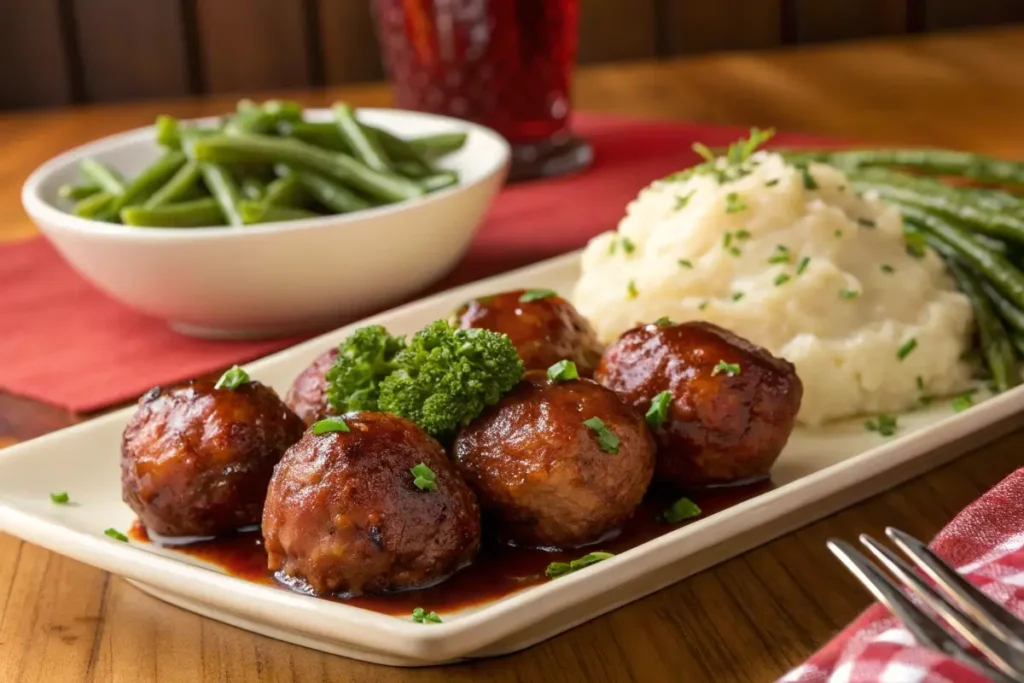
Pineapple-Glazed Ham Balls
For a tropical twist on the traditional ham balls recipe, incorporate crushed pineapple into the glaze. The natural sweetness and acidity of the pineapple complement the savory meatballs perfectly. Simply add half a cup of crushed pineapple (drained) to your glaze mixture and proceed as usual. This variation adds a delightful burst of flavor that’s sure to impress your guests.
Spicy Ham Balls with Mustard Sauce
If you prefer a bit of heat, try adding some spice to your ham balls. Incorporate a teaspoon of crushed red pepper flakes into the meat mixture for a subtle kick. For the glaze, mix in a tablespoon of Dijon mustard to add depth and tanginess. This combination creates a harmonious balance between spicy and savory, elevating the classic recipe to new heights.
Ham Balls with Brown Sugar and Vinegar Glaze
For those who enjoy a sweet and tangy profile, a brown sugar and vinegar glaze is the way to go. Combine one cup of brown sugar with half a cup of apple cider vinegar and a tablespoon of soy sauce. This glaze offers a rich, caramel-like sweetness with a hint of acidity, perfectly complementing the savory ham balls.
Tips and Tricks for Perfect Ham Balls Every Time
Choosing the Right Ham: Fresh vs. Leftover
One of the secrets to a great ham balls recipe is starting with the right ham. If you have leftover ham from a holiday meal, it’s a fantastic option because it already has rich flavor. However, store-bought ham works just as well. For best results, make sure it’s not too salty, as this can overpower the dish. When grinding the ham, aim for a fine texture that blends easily with the other ingredients.
Making Ahead and Freezing Ham Balls
Planning to save time? You can prepare the ham balls in advance and freeze them for later. After forming the balls, place them on a baking sheet and freeze until firm. Then, transfer them to an airtight container or freezer bag. When you’re ready to bake, simply thaw them in the fridge overnight and add the glaze before popping them in the oven. This tip is perfect for meal prepping or holiday planning.
Adjusting the Recipe for Dietary Preferences
Don’t hesitate to tweak the ham balls recipe to suit your family’s needs. For a gluten-free version, use gluten-free breadcrumbs or almond flour instead of graham crackers. If you’re looking to cut down on sugar, you can reduce the amount in the glaze or try a sugar substitute. These small changes can make the dish more inclusive without sacrificing flavor
FAQs
Are Fareway Ham Balls precooked?
Fareway Ham Balls are typically not precooked, so they must be cooked thoroughly before eating. Always refer to the packaging for specific instructions, but in general, you should bake ham balls until their internal temperature reaches 160°F (71°C) to ensure they are safe to eat.
What is the difference between ground ham and ground pork?
- Ground Ham:
- Made from cured ham, which is pork that has been seasoned and sometimes smoked.
- Has a salty and smoky flavor.
- Typically leaner and used in recipes like ham balls or ham loaves.
- Ground Pork:
- Made from raw, uncured pork, typically from the shoulder.
- Neutral in flavor, making it versatile for various dishes like meatballs, sausages, and stir-fries.
- Can have a higher fat content compared to ground ham.
How long can you keep cooked ham balls in the refrigerator?
Cooked ham balls can be stored in the refrigerator for 3 to 4 days if kept in an airtight container. For longer storage, you can freeze them for up to 3 months. Always ensure they are properly reheated to an internal temperature of 165°F (74°C) before serving.
How do you reheat frozen ham balls?
- In the Oven:
- Preheat the oven to 350°F (175°C).
- Place the frozen ham balls in a baking dish, cover with foil, and bake for 20-25 minutes or until heated through. If using sauce, add it before reheating.
- In the Microwave:
- Place the ham balls in a microwave-safe dish, cover with a lid or microwave-safe wrap.
- Heat on medium power in intervals of 1-2 minutes, stirring or flipping between intervals, until fully warmed.
- On the Stovetop:
- Add a small amount of water or sauce to a pan, then add the frozen ham balls.
- Cover and cook over medium heat, stirring occasionally, until heated through.
Would you like further details on cooking or storing ham balls? 😊
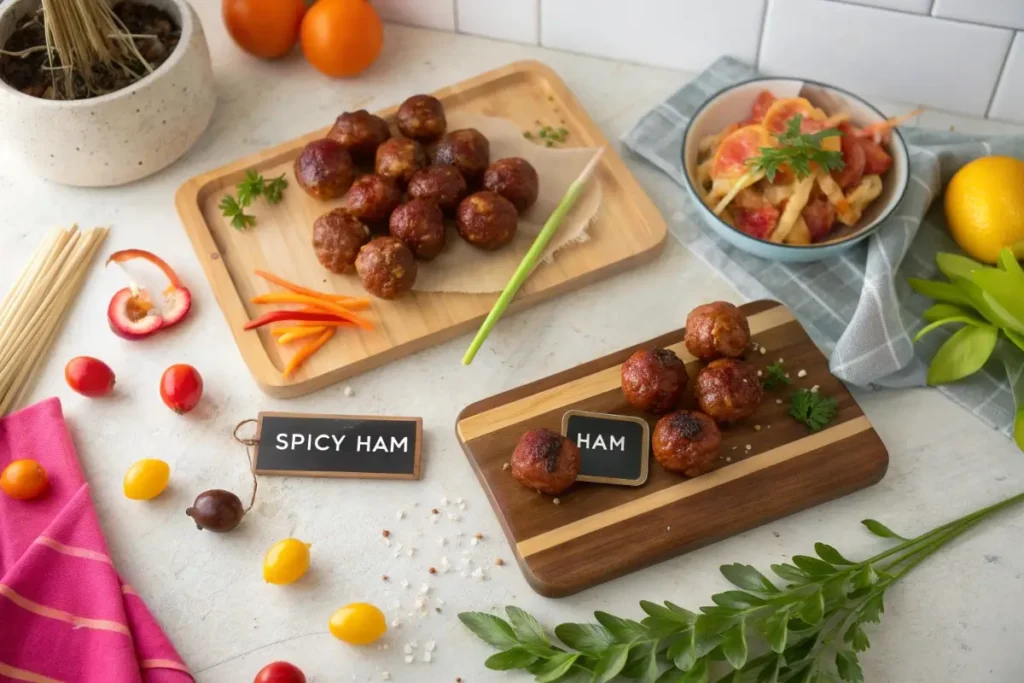
Conclusion (150 words)
Recap of the Ham Balls Recipe
This ham balls recipe is more than just a meal; it’s a cherished tradition that brings people together. From selecting the perfect mix of ground meats to crafting a sweet and tangy glaze, every step plays a role in creating this comforting dish. Whether you follow the classic method or try one of the tasty variations, ham balls are sure to delight.
Encouragement to Try the Recipe at Home
Why not give this recipe a try? It’s easier than it looks, and the results are absolutely worth it. Whether you’re cooking for a family dinner, a potluck, or simply craving something hearty, ham balls are a surefire hit. They’re versatile, delicious, and perfect for any occasion.
Invitation to Share Personal Twists on the Classic Dish
We’d love to hear how you make this dish your own! Share your twists on the ham balls recipe or tell us how your family enjoyed it. Your creativity might inspire others to try something new. Happy cooking!

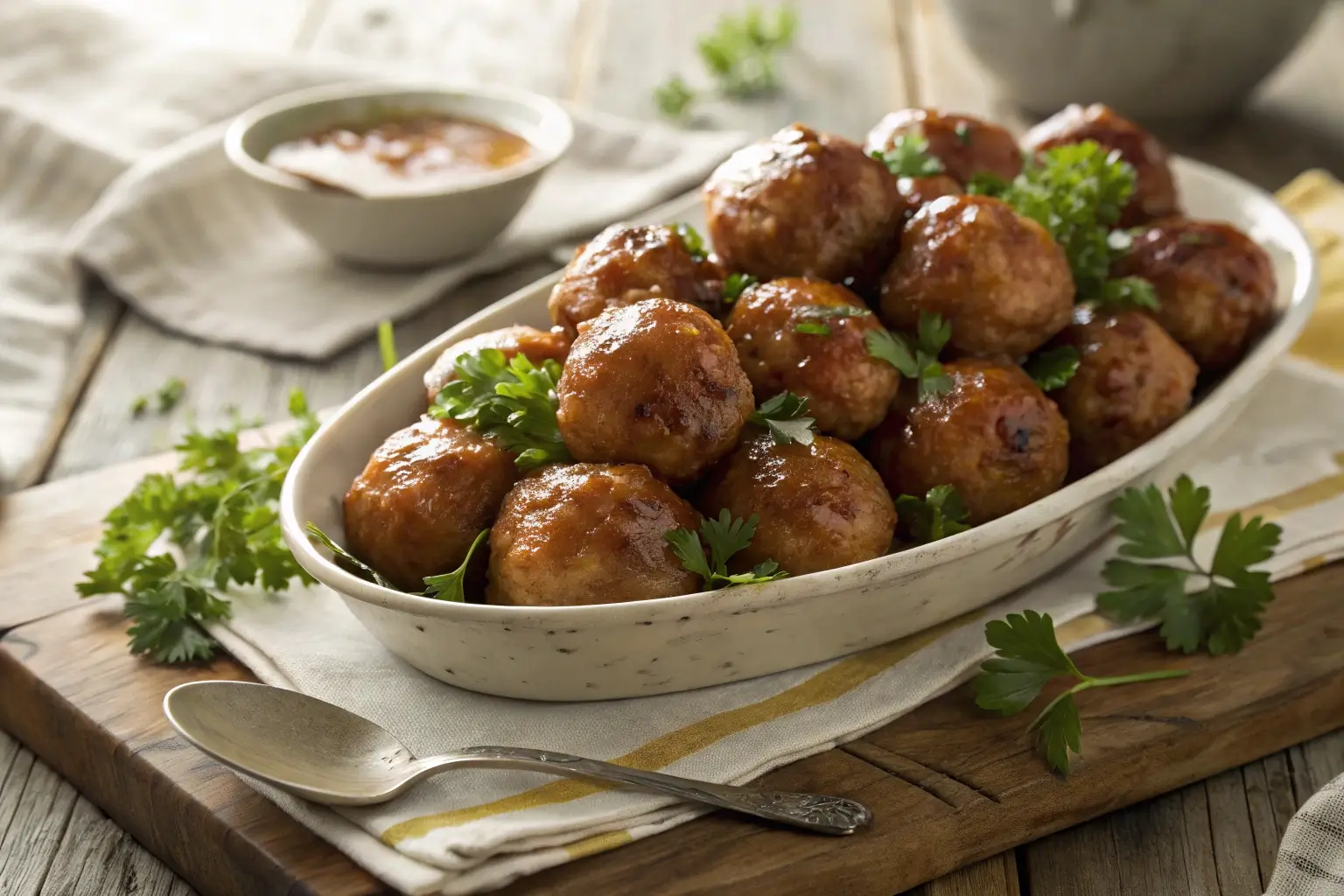
5 thoughts on “Ham Balls Recipe: Easy, Delicious, and Perfect Every Time”